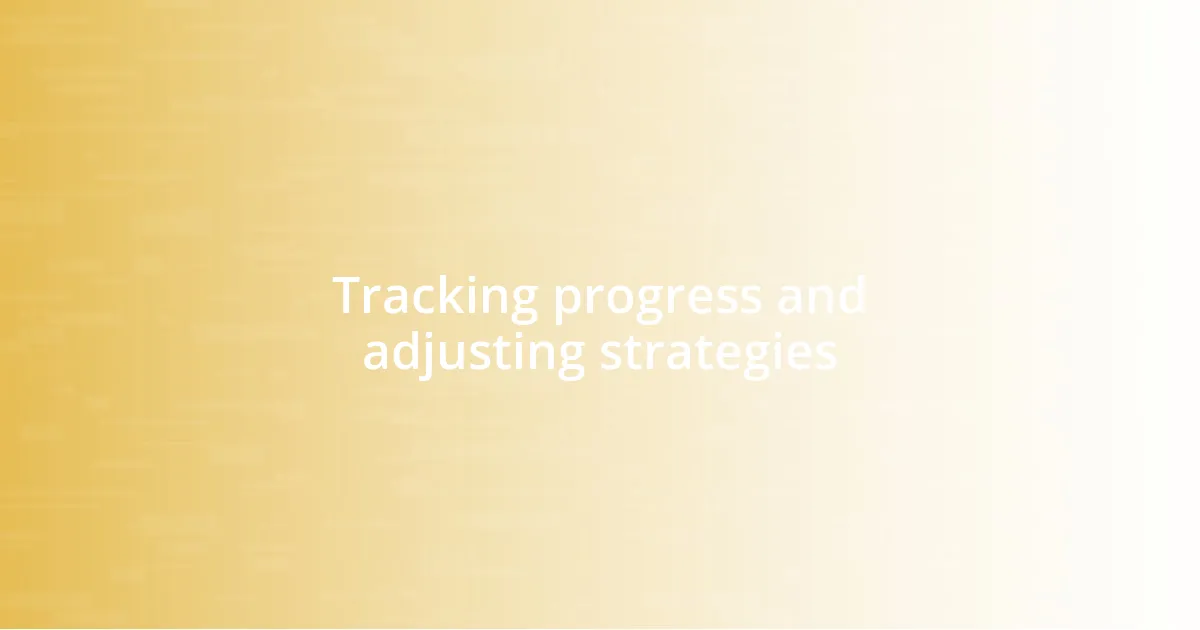Key takeaways:
- Treatment fatigue encompasses both physical exhaustion and emotional toll, often leading to feelings of loneliness and loss of joy.
- Recognizing symptoms like persistent tiredness, irritability, and emotional numbness is crucial for managing fatigue effectively.
- Incorporating regular rest, prioritizing activities, and utilizing uplifting distractions can significantly improve energy levels and overall well-being.
- Developing a self-care routine and tracking progress helps identify effective strategies, fostering resilience and adaptability during treatment.

Understanding treatment fatigue
Treatment fatigue can be a profound struggle, often creeping in when we least expect it. I remember a particularly tough day when I felt completely drained after what seemed like endless appointments and therapies. It led me to ask myself, how much more can my body handle before it feels like I’m running on empty?
The emotional toll of treatment fatigue often weighs heavier than the physical exhaustion. I’ve found myself sitting in a waiting room, feeling a deep sense of loneliness wash over me, even in a crowded space. It’s almost as if the fatigue steals not just my energy, but also my joy and motivation—making me wonder if anyone else experiences this inner battle.
At its core, understanding treatment fatigue means recognizing that it’s a multifaceted experience. It affected my ability to focus on things I once loved, like reading or meeting friends. Have you ever noticed how a single wave of fatigue can turn a bright day into a blur? That realization helped me appreciate the importance of acknowledging these feelings rather than brushing them aside.

Recognizing symptoms of treatment fatigue
Recognizing the symptoms of treatment fatigue is crucial for navigating your journey. I’ve learned to identify the subtle signals my body sends out, often before it overwhelms me. One moment, I’m functioning at a decent level, and the next, I find myself struggling to keep my eyes open during a favorite show. That creeping sense of exhaustion can manifest in various ways, often leaving me puzzled about its origin.
Here are some common symptoms to watch for:
- Persistent physical tiredness, despite rest
- Difficulty concentrating or making decisions
- Increased irritability or mood swings
- Loss of interest in activities you once enjoyed
- Sleep disturbances, even after a long night
- A feeling of emotional numbness or detachment
Paying attention to these signs has been my way of giving myself permission to slow down; it’s a practice I wish I had embraced sooner. The stark realization came for me on a rainy afternoon, when I couldn’t muster the energy to bake my favorite cookies—something that usually brings me joy. Recognizing that moment as a symptom rather than an unusual lapse reminded me it’s okay to rest and recharge instead of pushing through.

Strategies for managing treatment fatigue
There are several strategies that I find effective when it comes to managing treatment fatigue. One of my go-to methods is scheduling mini-breaks throughout my day. For instance, I’ve discovered that a simple five-minute walk around my home or a stretch can work wonders for recharging my energy levels. It’s almost like hitting a reset button; I return to my tasks feeling more focused and less overwhelmed.
Another key strategy is prioritizing my activities. I often create a list of what truly needs to be done, which helps prevent feeling inundated. Recently, I had a day piled high with chores. Instead of attempting to tackle them all, I selected just a few and felt significantly more accomplished by the day’s end. This practice not only reduces fatigue but also boosts my sense of achievement.
On days when treatment fatigue feels particularly heavy, I lean into uplifting distractions. Listening to favorite music or watching a light-hearted show usually lifts my spirits. I remember one evening, feeling utterly drained, yet I allowed myself the small indulgence of a silly film. Those laughter-filled moments make even the toughest days a bit brighter.
| Strategy | Description |
|---|---|
| Mini-breaks | Short breaks like stretching or walking can recharge your energy. |
| Prioritize activities | Focus on necessary tasks to avoid feeling overwhelmed. |
| Uplifting distractions | Engage in enjoyable activities like music or comedy for a mood boost. |

Incorporating rest into treatment plans
Incorporating rest into treatment plans is something I’ve come to see as non-negotiable. There was a time I believed that powering through fatigue would somehow make me stronger. Instead, I learned that I often felt worse. I now prioritize rest periods like any essential appointment, scheduling them into my day. This shift has made a tangible difference in how I approach my overall well-being.
I’ve also found it helpful to create a calming environment dedicated to relaxation. It might be as simple as a cozy corner of my living room, where I indulge in a few pages of a good book or take a nap. I remember the first time I allowed myself a full afternoon of just lounging. It felt almost indulgent, yet afterward, I was surprised by how rejuvenated I felt. How can we expect our bodies to heal if we don’t give them the time to recharge?
Additionally, I’ve learned to listen to my body’s rhythms, recognizing when fatigue is creeping in. If I feel my energy waning, I stop. I ask myself, “Do I really need to finish this task right now, or would it be more beneficial to rest?” This mindful approach is something I wish I had embraced earlier. By valuing rest, I nurture my resilience, allowing me to tackle challenges with renewed vigor.

Utilizing support systems effectively
Utilizing a support system effectively is one of the most impactful strategies I’ve uncovered in my journey with treatment fatigue. For me, having regular check-ins with friends and family allowed me to express how I was feeling about my treatment. I remember one evening, after a rough week, I reached out to a close friend. Just talking about my fatigue and hearing her encouragement felt like lifting a weight off my shoulders. Isn’t it amazing how simply sharing our challenges can create such relief?
Moreover, I’ve come to realize that seeking professional support is equally vital. Engaging with a therapist specializing in chronic illness can help provide tools for managing emotional fatigue. Before I started these sessions, I hadn’t recognized just how deeply my treatment affected my mental well-being. During one session, I learned about “cognitive reframing,” which helped me see fatigue not as a personal failure but as a natural response to my treatment. This perspective shift has been invaluable.
Lastly, I lean on support groups—both online and in-person—where individuals share similar experiences and strategies. I vividly recall joining an online forum; I found solace in realizing I wasn’t alone in my struggles. Reading others’ stories inspired me to adopt new practices that fit my lifestyle. If you’ve never tried it, why not step out of your comfort zone? Connecting with others can open doors to unexpected solutions and a sense of community that’s incredibly healing.

Developing a self-care routine
Developing a self-care routine has been a journey of exploration for me. At first, I thought it was just about indulging in bubble baths and face masks, but I quickly realized it’s more profound. The real essence of self-care for me has become about honoring my feelings and validating my experiences. When I intentionally carve out moments for myself, whether it’s meditating for ten minutes or simply enjoying a cup of tea in silence, I can almost feel my body exhaling in relief. Have you ever paused to just breathe and be present? It’s transformative.
One of my favorite aspects of my routine is incorporating movement in ways that feel good, rather than imposing strict workouts on myself. Some days, that means gentle stretching or a walk around the block, while on others, it’s a dance party in my living room. I remember one particularly exhausting day when I felt entirely drained. Instead of collapsing onto the couch, I turned on some music and let the rhythm guide me. Just fifteen minutes of moving my body shifted my mood from heavy to light. Isn’t it fascinating how active engagement can breathe new life into our spirits?
Finally, nurturing my passions plays a key role in my self-care ritual. I try to embrace activities that I genuinely enjoy, like painting or journaling, even when I don’t feel up to it. There was a week when fatigue felt like a dense fog surrounding me, and yet, sitting down with my watercolors sparked joy I didn’t know I had left. I realized that leaning into creativity, however small, can provide a refreshing escape from the rigors of treatment. Have you ever noticed how indulging in what you love makes the tough times more bearable? That’s the magic of a well-rounded self-care routine.

Tracking progress and adjusting strategies
Tracking my progress during treatment has become a vital part of managing fatigue. I often use a journal to jot down daily feelings and energy levels. It’s surprising how much clarity emerges when I look back at my notes. Just the other day, I noticed an inspiring pattern; on days when I took a morning walk, my energy soared. Isn’t it interesting how the simple act of reflection can shed light on what truly works for us?
I’ve learned that adjusting my strategies is just as crucial as tracking my progress. I remember a time when I pushed through a week of treatment without taking breaks. I felt utterly depleted. It was then that I realized the importance of pacing myself, and I started scheduling regular rest periods. Now, if fatigue sets in, I shift my plans rather than pushing harder. This adaptability has allowed me to navigate my treatment while maintaining some semblance of normalcy.
Sometimes, it’s the small changes that yield significant results. For instance, I’ve tried various self-care tactics—some worked wonders while others barely made a dent. I recall trying out meditation for the first time; surprisingly, it didn’t resonate with me. However, I stumbled upon sound baths, and instantly felt rejuvenated. It’s a gentle reminder that it’s okay to experiment until we find what truly resonates. How often do we give ourselves permission to redefine our approaches? Being open to change can foster unexpected growth amidst challenge.















